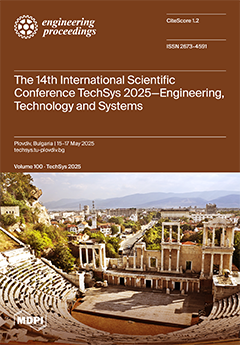Eng. Proc., 2025, TechSys 2025
The 14th International Scientific Conference TechSys 2025—Engineering, Technologies and Systems
Plovdiv, Bulgaria | 15–17 May 2025
Volume Editors:
Nikola G. Shakev, Technical University of Sofia, Bulgaria
Valyo N. Nikolov, Technical University of Sofia, Bulgaria
Nikolay R. Kakanakov, Technical University of Sofia, Bulgaria
Sevil A. Ahmed-Shieva, Technical University of Sofia, Bulgaria
- Issues are regarded as officially published after their release is announced to the table of contents alert mailing list.
- You may sign up for e-mail alerts to receive table of contents of newly released issues.
- PDF is the official format for papers published in both, html and pdf forms. To view the papers in pdf format, click on the "PDF Full-text" link, and use the free Adobe Reader to open them.




